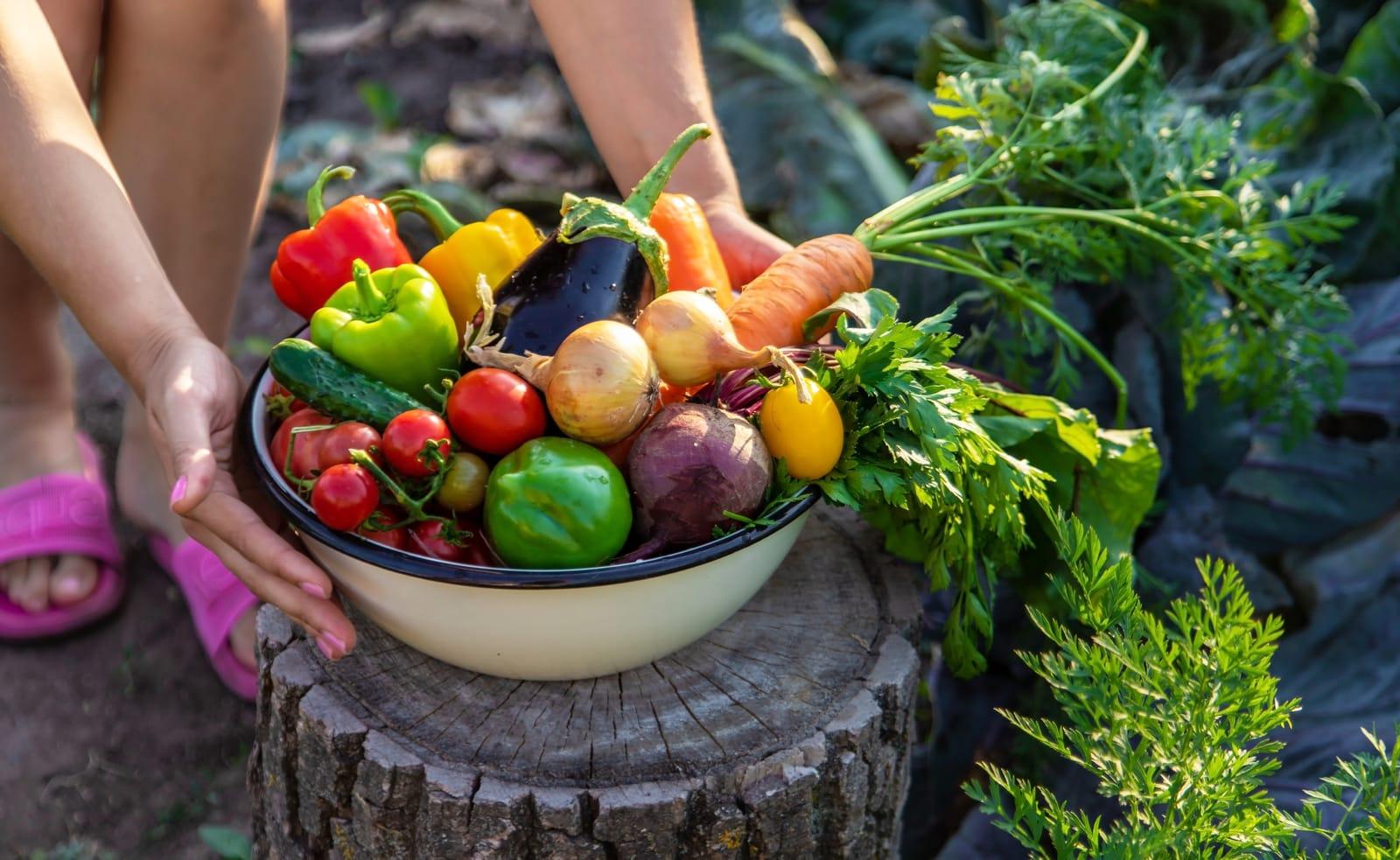16 Common Vegetables: Their Nutritional & Health Benefits

June 24, 2025 by Robert Dowling
Vegetables are full of health-promoting nutrients, vibrant, and adaptable. Based on their nutritional value, they are separated into categories such starchy, dark green, peas, beans, and lentils.
Depending on their age and gender, most adults should strive for 2-4 cups of veggies per day. Consuming vegetables on a daily basis can help you absorb more nutrients from food. They also aid in fullness, which facilitates simpler weight management.
Some of the healthiest and highest-nutrient veggies are discussed in this article.
1. Carrots
This is a root vegetable that is high in vitamin A. Beta carotene, fiber, antioxidants, potassium, vitamin K, and vital amino acids can all be found in good amounts in carrots.
Carrot phytochemicals seem to have antibacterial, anti-inflammatory, antioxidant, and anti-cancer properties. Carrots that have been cooked provide more beta carotene advantages than those that are raw.
Carotenemia, or yellow or orange skin, is a condition that can be brought on by eating a lot of foods high in carotene over several months.
2. Spinach
One of the leafiest, most nutrient-dense vegetables available is spinach. It offers significant levels of vitamins such as A, B, & K. It is rich in minerals, such as calcium, magnesium, iron, manganese, and copper. It also contains a lot of fiber, antioxidants, and important amino acids.
In addition to lowering cholesterol and blood sugar levels, spinach may help prevent certain malignancies. Spinach can make it difficult for the body to absorb magnesium and calcium, which might result in kidney stones, so you may prefer not to consume it every day. Blood-thinning medications and other drugs may not work well with it due to its high vitamin K content.
3. Broccoli
Broccoli is an excellent source of calcium, potassium, iron, and vitamins A, K, and C. It is also high in fiber. Broccoli possesses potent anti-inflammatory, anti-cancer, and antioxidant qualities. Broccoli is an excellent way to obtain your greens, either raw or cooked.
According to some study, cruciferous vegetables contain a chemical called indole glucosinolate that may interfere with thyroid hormones. However, not enough information is available to determine the minimum amount to trigger an issue.
Related: What is Broccoli? Health benefits and side effects
4. Brussels Sprouts
Along with other anti-oxidants, a single serving of the Brussels sprouts contains almost half the daily value (DV) of vitamin C. You also receive high levels of folate, potassium, and fiber. This cruciferous vegetable strengthens the immune system, supports healthy blood and bones, and may even help prevent certain malignancies. They are lower in calories yet aid in feeling full. Brussels sprouts lose some of their vitamin C content when they are boiled, so you may choose to roast, sauté, or steam them instead.
5. Kale
Vitamins A, C, K, and B6, manganese, and folate are all present in good amounts in kale. It has high levels of fiber, lutein, zeaxanthin, and carotenoids. Kale’s antioxidants aid in lowering oxidative stress and inflammation. This leafy green could be beneficial for digestive issues or constipation. It might also offer defense against obesity, cancer, and heart disease. Compared to cooked kale, raw kale has more nutritional value.
6. Bell Peppers
Though they are typically used as vegetables, bell peppers are actually fruits. They are available in a variety of hues, such as orange, red, yellow, and green. Although the nutritional value of them varies slightly based on hue, they are all high in nutrients.
Bioactive substances possessing anti-tumor, antibacterial, antifungal, antioxidant, and anti-diabetic activities are abundant in bell peppers. They also support a healthy immune system.
Related: What is Cayenne Pepper? Health benefits and side effects!
7. Garlic
Many different bioactive components in garlic are responsible for the majority of its health advantages, which include strong antioxidant qualities. Blood pressure and cholesterol may both be improved by garlic. Moreover, its anti-inflammatory properties might help reduce the chance of developing long-term conditions like diabetes, cardiovascular disease, and cancer.
Related: What is Garlic? Health benefits and side effects!
8. Asparagus
There are plenty of vitamins in asparagus. Moreover, it has high levels of fiber, protein, calcium, iron, copper, and folate. It can aid in weight management because it is low in calories and fat and increases feelings of fullness. Asparagus contains anti-cancer qualities and is beneficial for heart and bone health.
9. Beets
In addition to being strong in antioxidants, nitrates, folate, and vitamins, beets also contain a lot of fiber. This root veggie may help lower the chance of developing long-term conditions like cancer and cardiovascular disease. Additionally, beets may aid in preventing dementia and memory loss.
10. Red Cabbage
More than half the Daily Value (DV) for the vitamin C and vitamin K may be found in a cup of red cabbage. It also contains high levels of potassium, iron, and fiber.
Red cabbage’s reddish-purple color indicates that it contains anthocyanins, which have been connected to a decreased risk of heart disease. According to research, cruciferous veggies’ glucosinolates and its isothiocyanate metabolites may help prevent a few chronic illnesses.
11. Cauliflower
Large concentrations of minerals and vitamins, such as B vitamins, phosphorus, folate, and C and K vitamins, are found in cauliflower. Because cruciferous vegetables are high in fiber and low in calories, they promote fullness. Regular consumption is linked to a lower incidence of depression, all-cause mortality, and some malignancies. Boiling cauliflower reduces its nutritional value. Eating it raw, boiled, stir-fried, or microwaved will maximize its health advantages.
12. Fermented Vegetables
Fermenting can boost or decrease certain nutrients, depending on the vegetable. In any case, vegetables that have undergone fermentation are rich in probiotic bacteria, which may increase metabolism and reduce the likelihood of obesity, gastrointestinal disorders, and chronic illnesses. Since fermented foods typically contain a lot of salt, moderation is essential.
13. Seaweed
Depending on the type, seaweed has different nutritional values. Seaweed generally has a high mineral content. It helps to maintain intestinal health and is strong in fiber. Omega-3 fatty acids, carotenoids, and polyphenols found in seaweed also aid in disease prevention.
14. Onions
Onions’ bioactive components provide a variety of health advantages. They have anti-inflammatory, antibacterial, and antioxidant properties. They might also offer defense against heart disease, cancer, and diabetes. Additionally, they support healthy immunological, reproductive, and digestive systems.
15. Tomatoes
Fruits like tomatoes are full with antioxidants like vitamin C. Tomatoes have the potential to reduce the risk of gastrointestinal, cardiac, and neurological illnesses. Tomatoes are also beneficial to the skin and immune system.
Rich in lycopene, with anti-cancer qualities, tomatoes are a nutrient-dense food that may be eaten raw or cooked. However, the body may absorb lycopene from baked tomatoes more readily than from raw ones.
16. Alfalfa Sprouts
Alfalfa sprouts have only 8 calories per cup, of which 51% are derived from protein. They also include a respectable quantity of B, K, and C vitamins. Alfalfa sprouts include a multitude of bioactive chemicals that possess antiviral, antioxidant, and anti-diabetic qualities. They benefit the immune system as well.
Concluding Remark
A diet high in fruits and vegetables is considered healthy and balanced. There are differences in the amount of nutrients found in different plants. Every one offers a different combination of healthful qualities. By mixing up various type of vegetables at each meal, you’ll reap even more health advantages.






